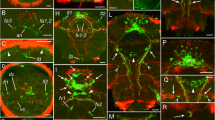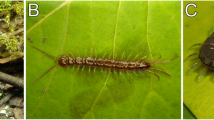Abstract
The nervous system of invertebrates is considered to be a very conservative organ system and thus can be helpful to elucidate questions of phylogenetic relationships. Up to now, comparative neuroanatomical studies have been mainly focused on arthropods, where in-depth studies on major brain structures are abundant. In contrast, except for Gastropoda and Cephalopoda, the nervous system of representatives of the second largest phylum of invertebrates, the Mollusca, is as yet hardly investigated. We therefore initiated an immunohistochemical survey to contribute new neuroanatomical data for several molluscan taxa, especially the lesser known Caudofoveata, Solenogastres, Polyplacophora, and Scaphopoda, focusing on the cellular architecture and distribution of neurotransmitters in the brain. Antisera against the widespread neuroactive substances FMRFamide and serotonin were used to label subsets of neurons. Both antisera were additionally used in combination with acetylated α-tubulin and the nuclear marker DAPI. This enables us to describe the morphology of the nervous system at a fine resolution and to compare its cellular architecture between different species of one taxon, as well as between different taxa of mollusks. On the basis of these results, the nervous system of caudofoveates seems to be most highly derived within the so-called basal (non-conchiferan) mollusks, and a monophyly of a clade Aplacophora could not be confirmed. In general, the brain as well as the remaining nervous system of the molluscan taxa investigated shows a great variability, suggesting a deep time origin of the diversification of this prominent protostome clade.












Similar content being viewed by others
References
Aktipis SW, Giribet G, Lindberg DR, Ponder WF (2008) Gastropoda: an overview and analysis. In: Ponder WF, Lindberg DR (eds) Phylogeny and evolution of the Mollusca. University of California Press, Berkeley, pp 201–238
Audesirk G, McCaman RE, Denniswillows AO (1979) Role of serotonin in the control of pedal ciliary activity by identified neurons in Tritonia diomedea. Comp Biochem Physiol C 62:87–91
Büchinger T (1998) Vergleichende Untersuchungen am Nervensystem von Solenogastres (Mollusca). Dissertation. University of Vienna, Vienna
Budelmann BU, Schipp R, Boletzky S (1997) Cephalopoda. In: Harrison FW, Kohn AB (eds) Microscopic anatomy of invertebrates. Mollusca II, vol 6A. Wiley-Liss, New York, pp 119–414
Eernisse DJ, Reynolds PD (1994) Polyplacophora. In: Harrison FW, Kohn AJ (eds) Microscopic anatomy of invertebrates. Mollusca I, vol 5. Wiley-Liss, New York, pp 55–110
Gantner R (1989) Morphologie und Nervensystem der Käferschneckenart Lepidochitona monterosatoi (Mollusca, Polyplacophora). Diplomarbeit, Technische Universität München
Glaubrecht M, Maitas L, Salvini-Plawen Lv (2005) Aplacophoran Mollusca in the natural history museum Berlin. An annotated catalogue of Thiele’s type specimens, with a brief review of “Aplacophora” classification. Mitt Mus Natkd Berl Zool Reihe 81:145–166
Hanström B (1928) Vergleichende Anatomie des Nervensystems der wirbellosen Tiere unter Berücksichtigung seiner Funktion. Julius Springer, Berlin
Harzsch S (2002) Neurobiologie und Evolutionsforschung: “Neurophylogenie” und die Stammesgeschichte der Euarthropoda. Neuroforum 4:267–273
Harzsch S (2006) The architecture of the nervous system provides important characters for phylogenetic reconstructions: examples from the Arthropoda. Species Phylogeny Evol 1:33–57
Haszprunar G (1987) The fine morphology of the osphradial sense organs of the Mollusca. IV. Caudofoveata and Solenogastres. Philos Trans R Soc B 315:63–73
Haszprunar G (1988) On the origin and evolution of major gastropod groups, with special reference to the Streptoneura. J Moll Stud 54:367–441
Haszprunar G (2000) Is the Aplacophora monophyletic? A cladistic point of view. Am Malac Bull 15:115–130
Haszprunar G, Schander C, Halanych KM (2008) Relationships of higher molluscan taxa. In: Ponder WF, Lindberg DR (eds) Phylogeny and evolution of the Mollusca. University of California Press, Berkeley, pp 19–32
Heuer CM, Loesel R (2008) Immunofluorescence analysis of the internal brain anatomy of Nereis diversicolor (Polychaeta, Annelida). Cell Tissue Res 331:713–724
Heuer CM, Müller CHG, Todt C, Loesel R (2010) Comparative neuroanatomy suggests repeated reduction of neuroarchitectural complexity in Annelida. Front Zool 7:13
Hoffman S (1949) Studien über das Integument der Solenogastren nebst Bemerkungen über die Verwandtschaft zwischen den Solenogastren und Placophoren. Zool Bidrag Uppsala 27:293–427
Hyman LH (1967) Class Aplacophora. In: Hyman LH (ed) The invertebrates. Mollusca I, vol 6. McGraw-Hill, New York, pp 13–70
Kocot KM, Cannon JT, Todt C, Citarella MR, Kohn AB, Meyer A, Santos SR, Schander C, Moroz LL, Lieb B, Halanych KM (2011) Phylogenomics reveals deep molluscan relationships. Nature 477:452–456
Loesel R (2005) The arthropod brain: retracing six hundred million years of evolution. Arthropod Struct Dev 34:207–209
Loesel R (2011) Neurophylogeny: retracing early metazoan brain evolution. In: Pontarotti P (ed) Evolutionary biology: concepts, biodiversity, macroevolution, and genome evolution. Springer, Berlin, pp 169–191
Loesel R, Nässel DR, Strausfeld NJ (2002) Common design in a unique midline neuropil in the brains of arthropods. Arthropod Struct Dev 31:77–91
Moroz L, Nezlin L, Elofsson R, Sakharov D (1994) Serotonin- and FMRFamide-immunoreactive nerve elements in the chiton Lepidopleurus asellus (Mollusca, Polyplacophora). Cell Tissue Res 275:277–282
Passamaneck YJ, Schander C, Halanych KM (2004) Investigation of molluscan phylogeny using large-subunit and small-subunit nuclear rRNA sequences. Mol Phylogent Evol 32:25–38
Paul DH (1989) A neurophylogenist’s view of decapod Crustacea. Bull Mar Sci 45:487–504
Ratté S, Chase R (1997) Morphology of interneurons in the procerebrum of the snail Helix aspersa. J Comp Neurol 384:359–372
Redl E, Salvini-Plawen Lv (2009) Das Nervensystem der Caudofoveata (Mollusca). VDM Verlag Dr. Müller, Saarbrücken
Reynolds PD, Steiner G (2008) Scaphopoda. In: Ponder WF, Lindberg DR (eds) Phylogeny and evolution of the Mollusca. University of California Press, Berkeley, pp 143–161
Richter S, Loesel R, Purschke G, Schmidt-Rhaesa A, Scholtz G, Stach T, Vogt L, Wanninger A, Brenneis G, Döring C, Faller S, Fritsch M, Grobe P, Heuer CM, Kaul S, Møller OS, Müller CHG, Rieger V, Rothe BH, Stegner MJ, Harzsch S (2010) Invertebrate neurophylogeny: suggested terms and definitions for a neuroanatomical glossary. Front Zool 7:29
Rodriguez J, Deinhardt F (1960) Preparation of a semipermanent mounting medium for fluorescent antibody studies. Virology 12:316–317
Runnegar B, Pojeta J (1974) Molluscan phylogeny: the paleontological viewpoint. Science 186:311–317
Salvini-Plawen Lv (1967) Neue scandinavische Aplacophora. Sarsia 27:1–63
Salvini-Plawen Lv (1972) Zur Morphologie und Phylogenie der Mollusken: Die Beziehungen der Caudofoveata und der Solenogastres als Aculifera, als Mollusca und als Spiralia. Z Wiss Zool 184:205–394
Salvini-Plawen Lv (1980) A reconsideration of systematics in the Mollusca (Phylogeny and higher classification). Malacologia 19:249–278
Salvini-Plawen Lv (1981) On the origin and evolution of the Mollusca. Atti dei Convegni Lincei 49:235–293
Salvini-Plawen Lv (2003) On the phylogenetic significance of the aplacophoran Mollusca. Iberus 21:67–97
Salvini-Plawen Lv, Steiner G (1996) Synapomorphies and plesiomorphies in higher classification of Mollusca. In: Taylor J (ed) Origin and evolutionary radiation of the Mollusca. Oxford University Press, Oxford, pp 29–51
Sasaki T, Shigeno S, Tanabe K (2010) Anatomy of living Nautilus: reevaluation of primitiveness and comparison with Coleoidea. In: Tanabe K, Shigeta Y, Sasaki T, Hirano H (eds) Cephalopods—present and past. Tokai University Press, Tokyo, pp 33–66
Scheltema AH (1993) Aplacophora as progenetic aculiferans and the coelomate origin of mollusks as the sister taxon of sipuncula. Biol Bull 184:57–78
Scheltema AH, Tscherkassky M, Kuzirian AM (1994) Aplacophora. In: Harrison FW, Kohn AJ (eds) Microscopic anatomy of invertebrates. Mollusca I, vol 5. Wiley-Liss, New York, pp 13–54
Schwabl M (1955) Rupertomenia fodiens nov. gen., nov. spec., eine neue Lepidomeniide von der Südwestküste Schwedens. Österr Zool Z 6:90–146
Shigeno S, Yamamoto M (2002) Organization of the nervous system in the pygmy cuttlefish, Idiosepius paradoxus Ortmann (Idiosepiidae, Cephalopoda). J Morphol 254:65–80
Shigeno S, Sasaki T, Haszprunar G (2007) Central nervous system of Chaetoderma japonicum (Caudofoveata, Aplacophora): implications for diversified ganglionic plans in early molluscan evolution. Biol Bull 213:122–134
Shimek RL, Steiner G (1997) Scaphopoda. In: Harrison FW, Kohn AJ (eds) Microscopic anatomy of invertebrates. Mollusca II, vol 6B. Wiley-Liss, New York, pp 719–781
Smith SA, Wilson NG, Goetz FE, Feehery C, Andrade SCS, Rouse GW, Giribet G, Dunn CW (2011) Resolving the evolutionary relationships of molluscs with phylogenomic tolls. Nature 480:364–367
Steiner G, Dreyer H (2003) Molecular phylogeny of Scaphopoda (Mollusca) inferred from 18S rDNA sequences: support for a Scaphopoda-Cephalopoda clade. Zool Scr 32:343–356
Strausfeld NJ (1998) Crustacean—insect relationships: the use of brain characters to derive phylogeny amongst segmented invertebrates. Brain Behav Evol 52:186–206
Strausfeld NJ, Andrew DR (2011) A new view of insect-crustacean relationships. I. Inferences from neural cladistics and comparative neuroanatomy. Arthropod Struct Dev 40:276–288
Strausfeld NJ, Buschbeck EK, Gomez RS (1995) The arthropod mushroom body: its functional roles, evolutionary enigmas and mistaken identities. In: Breidbach O, Kutsch W (eds) The nervous system of invertebrates: an evolutionary and comparative approach. Birkhäuser Verlag, Basel, pp 349–381
Todt C, Büchinger T, Wanninger A (2008a) The nervous system of the basal mollusk Wirenia argentea (Solenogastres): a study employing immunocytochemical and 3D reconstruction techniques. Mar Biol Res 4:290–303
Todt C, Okusu A, Schander C, Schwabe E (2008b) Solenogastres, Caudofoveata, and Polyplacophora. In: Ponder WF, Lindberg DR (eds) Phylogeny and evolution of the Mollusca. University of California Press, Berkeley, pp 71–96
Vinther J, Sperling EA, Briggs DEG, Peterson KJ (2011) A molecular palaeobiological hypothesis for the origin of aplacophoran molluscs and their derivation from chiton-like ancestors. Proc R Soc B (published online 5 October 2011)
Wollesen T, Loesel R, Wanninger A (2008) FMRFamide-like immunoreactivity in the central nervous system of the cephalopod mollusc, Idiosepius notoides. Acta Biol Hung 59:111–116
Acknowledgments
Funding for this study was provided by DFG grant LO797/3-2, LO797/3-3 and SCHM1278/8-2, SCHM1278/8-3 as part of the Priority Program 1174—“Deep Metazoan Phylogeny” of the German Science Foundation.
Author information
Authors and Affiliations
Corresponding author
Additional information
Communicated by T. Bartolomaeus.
Rights and permissions
About this article
Cite this article
Faller, S., Rothe, B.H., Todt, C. et al. Comparative neuroanatomy of Caudofoveata, Solenogastres, Polyplacophora, and Scaphopoda (Mollusca) and its phylogenetic implications. Zoomorphology 131, 149–170 (2012). https://doi.org/10.1007/s00435-012-0150-7
Received:
Revised:
Accepted:
Published:
Issue Date:
DOI: https://doi.org/10.1007/s00435-012-0150-7




